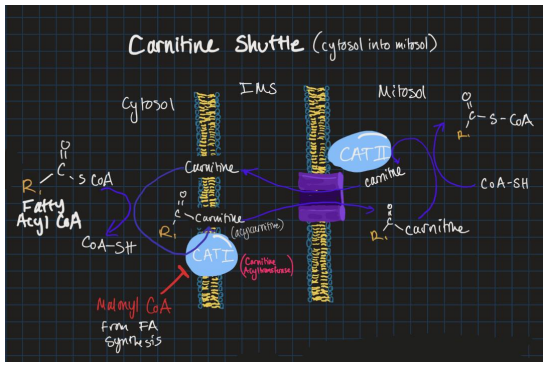Delivery Of Fuel To The Mitochondria

Oxaloacetate (OAA) is the rate limiting factor for the TCA (Krebs) cycle. Pyruvate can be converted to OAA via pyruvate carboxylase. Glycolysis will generate this pyruvate as well as important reducing agents (e.g. NADH). However, because glycolysis occurs in the cytoplasm and TCA occurs in the cytosol, OAA/NADH must be transported.
Malate-Aspartate Shuttle
The Malate-Aspartate Shuttle will transport NADH/oxaloacetate from glycolysis across the inner mitochondrial membrane. Organs which don't rely on aerobic glucose metabolism require this.
The elegance of this shuttle is beautiful in a way. Observe how to the two transporters share materials.
Malate transporter (to mitochondria):
- NADH transfers its electrons to oxaloacetate, converting it to malate (via malate dehydrogenase)
- Malate is transported into the mitochondrial matrix through the malate-α-ketoglutarate antiporter (exchanged for an alpha-ketoglutarate)
- Malate is oxidized back to oxaloacetate, and NADH is regenerated
Aspartate transporter (to cytoplasm):
- Oxaloacetate converted to aspartate from glutamate (via aspartate aminotransferase), generating an alpha-ketoglutarate
- Aspartate is transported back to the cytoplasm (exchanged for a glutamate)
- Aspartate is converted back to oxaloacetate

Glycerol 3-Phosphate Shuttle
Converts cytoplasmic NADH to mitochondrial FADH2. This is most common in the skeletal muscle and brain (high glucose utilizers). This is a fast way to regenerate NAD+ for GADPH in aerobic conditions (can't use the TCA cycle without oxygen).
FADH2 has a lower ATP yield than NADH, making this shuttle less than Malate-Aspartate, but is faster.
- NADH reduces dihydroxyacetone phosphate (DHAP) to G3P (via G3P dehydrogenase)
- G3P is transported to the inner mitochondrial membrane
- G3P is oxidized back to DHAP (generating FADH2)
Carnitine Shuttle
This will transport fatty acids into the outer and inner mitochondrial membranes. Using this system, fatty acids are converted into acyl-carnitine (1 ATP consumed). Use of ATP makes conversion to fatty acyl-CoA energetically expensive.
- ATP is added to the fatty acid, creating a location for CoA-SH to bind to the chain.
- ATP is kicked off, and fatty acyl-CoA will bind carnitine, catalyzed by carnitine acyltransferase I (CAT I), which allows it to pass the membrane.
As carnitine-bound fatty acids cross the outer membrane, carnitine acyl transferase II (CAT II) will remove the carnitine. Fatty acyl-CoA can now be used for beta-oxidation in the mitosol.
The carnitine shuttle is regulated by malonyl-CoA which inhibits CAT I. Malonyl-CoA is an intermediate of fatty acid synthesis.
